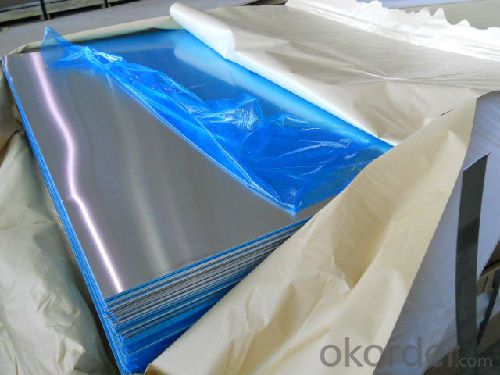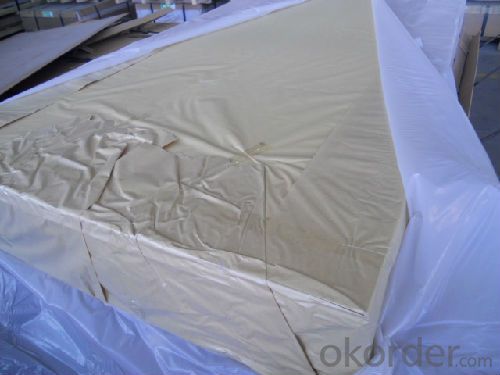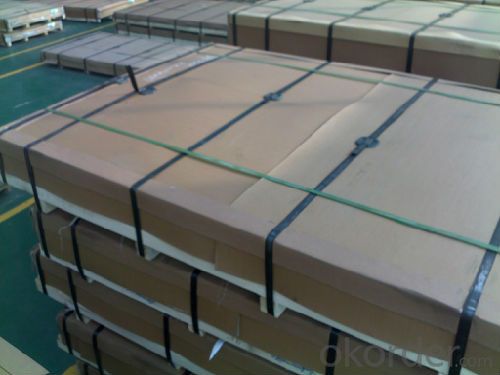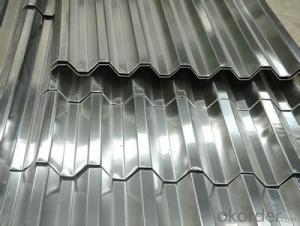Aluminium Sheets for Roofing with High Quality
- Loading Port:
- Shanghai
- Payment Terms:
- TT or LC
- Min Order Qty:
- 5 m.t.
- Supply Capability:
- 10000 m.t./month
OKorder Service Pledge
OKorder Financial Service
You Might Also Like
1.Structure of Aluminum Sheets for Roofing with High Quality
Our aluminum sheets for roofing are good at ductility, heat conductivity, anti-corrosion and moisture resistance. They are widely used in roofing, electronics, instruments, lighting decoration, packing, decoration, curtain wall, sandwich panels, boats, etc.
Our aluminum sheets can meet the highest standards while save the cost. Our strong quality control term bring you the most-qualified products.
2.Main Features of Aluminum Sheets for Roofing with High Quality
•High intensity
•Easy to be processed and shaped
•Weather resistance
•Anti-pollution & environment protection
3. Aluminum Sheets for Roofing Images with High Quality



4.Specification of Aluminum Sheets for Roofing with High Quality
Alloy | AA1050,AA1060, AA1070, AA1100 |
Temper: | H12, H14, H16, H18, H22, H24, H26, H32,HO, F |
Thickness: | 0.10-500mm |
Width: | 10mm- 2200mm |
Standard: | GB/T3880-2006, ASTM, ISO, EU standard |
Special Specification is available on customer’s requirement | |
5. FAQ
A.What about inspections to guarantee quality?
For each order for Aluminum Sheets, we will arrange strict inspection for raw materials, inspection during production and inspection for finished goods.
With requirement of customers, we also can arrange the third party inspection.
B.What about delivery?
We will put order for Aluminum Sheets in production schedule after order gets confirmed against copy of TT or L/C. Normally it takes about one month for production. Exact shipment schedule is different based on different sizes and quantity.
C.What is the MOQ?
5 tons for each size.
D. Where have you exported aluminium sheets?
We have exported aluminum sheets to many countries. Main markets include South East Asia, Middle East, North America, South America, etc.
- Q:i want to build a smelter to recycle aluminum auto parts
- Aluminium is usually recycled in the following basic way[2]: In the case of products like aluminium drink cans, the cans are shredded and ground into small pieces. The small pieces are then melted in a furnace to produce molten aluminium (by the end of this stage the recycled aluminium is indistinguishable from virgin aluminium and so further processing is identical for both). Some minor adjustments to the actual composition of the final product is required to eliminate impurities and to conform the recycled aluminium to the proper amalgam from which different materials are manufactured, including slightly different compositions for can bodies and lids. The molten aluminium is then poured in to moulds to create large ingots. The ingots are then forced through rollers to create sheets of aluminium of whatever thickness is required for the product the metal will be used in. The scrap aluminium is separated into a range of categories i.e. irony aluminium (engine blocks etc), alloy wheels, clean aluminium Depending on the specification of the required ingot casting will depend on the type of scrap used in the start melt. Generally the scrap is charged to a reverbatory furnace (other methods appear to be either less economical and/ or dangerous)and melted down to form a bath. the molten metal is tested using spectroscopy on a sample taken from the melt to determine what refinements are needed to produce the final casts. After the refinements have been added the melt may be tested several times to be able to fine tune the batch to the specific standard Once the correct recipe of metal is available the furnace is tapped and poured into ingot moulds, usually via a casting machine. The melt is then left to cool, stacked and sold on as cast silicon aluminium ingot to various industries for re-use.
- Q:How do you prevent oxidation of aluminum sheets?
- To avoid oxidation of aluminum sheets, several techniques can be utilized. One commonly used method is to apply a protective coating or finish on the surface of the aluminum sheets. This coating acts as a barrier between the aluminum and the external environment, preventing the metal from reacting with oxygen and forming an oxide layer. There are various types of coatings available for this purpose, such as anodizing, painting, and powder coating. Anodizing involves creating a controlled oxide layer on the aluminum surface through electrolysis. This oxide layer is highly resistant to corrosion and provides excellent protection against oxidation. Painting and powder coating, on the other hand, involve applying a layer of paint or powdered polymer to the aluminum surface. These coatings create a physical barrier that shields the metal from oxygen and moisture. Another effective approach to prevent oxidation is by using aluminum alloys that have enhanced corrosion resistance. These alloys are specifically designed to have a higher resistance to oxidation and can withstand exposure to harsh environments without forming a significant oxide layer. In addition to coatings and alloy selection, proper storage and handling practices play a crucial role in preventing oxidation. It is important to store aluminum sheets in a clean, dry, and well-ventilated area to minimize exposure to moisture and corrosive elements. Contact with acidic or alkaline substances should be avoided, as they can accelerate the oxidation process. Regular cleaning and maintenance of aluminum sheets also help prevent oxidation by removing any contaminants that could promote corrosion. In summary, preventing oxidation of aluminum sheets involves a combination of protective coatings, appropriate alloy selection, and proper storage and handling practices. By implementing these measures, the lifespan and durability of aluminum sheets can be significantly improved.
- Q:How are aluminum sheets cleaned and maintained?
- Aluminum sheets can be cleaned and maintained by following a few simple steps. Firstly, they should be wiped down regularly with a soft cloth or sponge and mild detergent to remove any dirt or grime. Avoid using abrasive materials or cleaners that contain bleach or ammonia, as they can damage the surface. After cleaning, it is recommended to rinse the sheets thoroughly with clean water and dry them with a soft cloth to prevent water spots. To maintain their shine, applying a coat of aluminum polish or a mixture of vinegar and water can help remove any oxidation or dullness. Additionally, it is important to protect aluminum sheets from harsh elements by storing them in a dry and clean environment and avoiding contact with corrosive substances.
- Q:Can aluminum sheets be an alternative to glass in certain applications?
- Yes, aluminum sheets can be an alternative to glass in certain applications. Aluminum sheets offer several advantages over glass, making them a suitable choice in specific scenarios. Firstly, aluminum sheets are lightweight and durable, making them ideal for applications where weight is a concern, such as in aerospace or automotive industries. Glass, on the other hand, is relatively heavy and brittle, which can limit its use in certain environments. Additionally, aluminum sheets have excellent corrosion resistance, making them suitable for applications in marine or coastal environments where glass may deteriorate over time due to exposure to saltwater. Aluminum sheets also have a high strength-to-weight ratio, allowing for greater design flexibility and structural integrity compared to glass. Moreover, aluminum sheets can provide better thermal insulation properties compared to glass. They offer improved heat transfer resistance, which can be advantageous in applications where temperature control is crucial, such as in the construction industry. Furthermore, aluminum sheets can be more cost-effective than glass in certain applications. The production and installation costs of aluminum sheets are often lower compared to glass, making them a more economical choice for large-scale projects. However, it is important to note that glass still has its own unique properties and advantages that make it the preferred choice in many applications, such as its transparency and optical clarity. Glass also offers better resistance to scratches and chemical corrosion compared to aluminum sheets. In conclusion, while aluminum sheets can be a viable alternative to glass in certain applications due to their lightweight, durability, corrosion resistance, thermal insulation properties, and cost-effectiveness, the choice between the two materials ultimately depends on the specific requirements and constraints of the application in question.
- Q:I am doing a project on Aluminum it has 13 protons just to make sure everyones on the same page. How much of it is left or exsits? Also how does it behave?
- Aluminium is one of the most abundant Element on earth, ranking 3rd in the crust, second only to oxygen and silicon. And it is eminently recyclable. However, many minerals containing aluminium are not economically exploitable.
- Q:What are the common uses of aluminum sheets?
- Aluminum sheets have a wide range of common uses across various industries. They are often used in construction for roofing, siding, and structural components due to their lightweight and durable nature. In the transportation sector, aluminum sheets are utilized in the manufacturing of vehicles, including cars, airplanes, and boats, to reduce weight and improve fuel efficiency. Additionally, aluminum sheets are commonly used in packaging, electrical appliances, and signage due to their corrosion resistance and ability to be easily formed into different shapes.
- Q:Can aluminum sheets be used for HVAC systems?
- Yes, aluminum sheets can be used for HVAC systems. Aluminum is a popular material choice for HVAC applications due to its many advantageous properties. It is lightweight, making it easier to handle and install. Aluminum is also highly resistant to corrosion, which is crucial for HVAC systems that are exposed to moisture and varying temperatures. Additionally, aluminum has excellent thermal conductivity, allowing for efficient heat transfer. This makes it ideal for heat exchangers and other components in HVAC systems. Overall, aluminum sheets are a reliable and durable option for HVAC systems.
- Q:How to clean the engine oil and kerosene on the surface of aluminum sheet?
- you can buy a bottle of petroleum ether in chemical raw material shop, it will be clean after rubbing, or you can buy solvent oil.
- Q:Can aluminum sheet be used for solar panels?
- Absolutely! When it comes to solar panels, aluminum sheet is a fantastic choice. Thanks to its remarkable strength, durability, and lightweight nature, aluminum is a widely favored material for constructing these panels. Its versatility shines through as it serves as both the frame and mounting structure, providing unparalleled support and stability. Moreover, its exceptional resistance to corrosion is a crucial factor given the panels' exposure to the elements. On top of all that, aluminum's highly conductive properties allow for efficient electricity transfer from the solar cells within the panel. All in all, incorporating aluminum sheet into solar panel construction significantly enhances their performance, longevity, and overall efficiency.
- Q:Can 101 aluminum sheets be recycled?
- Yes, 101 aluminum sheets can be recycled. Aluminum is highly recyclable, and the recycling process for aluminum is quite efficient. By recycling aluminum sheets, valuable resources can be conserved, energy can be saved, and greenhouse gas emissions can be reduced. Recycling aluminum also helps in reducing landfill waste and the need for mining new aluminum ores. Therefore, it is recommended to recycle 101 aluminum sheets to contribute to a more sustainable and environmentally friendly future.
1. Manufacturer Overview |
|
|---|---|
| Location | |
| Year Established | |
| Annual Output Value | |
| Main Markets | |
| Company Certifications | |
2. Manufacturer Certificates |
|
|---|---|
| a) Certification Name | |
| Range | |
| Reference | |
| Validity Period | |
3. Manufacturer Capability |
|
|---|---|
| a)Trade Capacity | |
| Nearest Port | |
| Export Percentage | |
| No.of Employees in Trade Department | |
| Language Spoken: | |
| b)Factory Information | |
| Factory Size: | |
| No. of Production Lines | |
| Contract Manufacturing | |
| Product Price Range | |
Send your message to us
Aluminium Sheets for Roofing with High Quality
- Loading Port:
- Shanghai
- Payment Terms:
- TT or LC
- Min Order Qty:
- 5 m.t.
- Supply Capability:
- 10000 m.t./month
OKorder Service Pledge
OKorder Financial Service
Similar products
New products
Hot products
Hot Searches
Related keywords






























